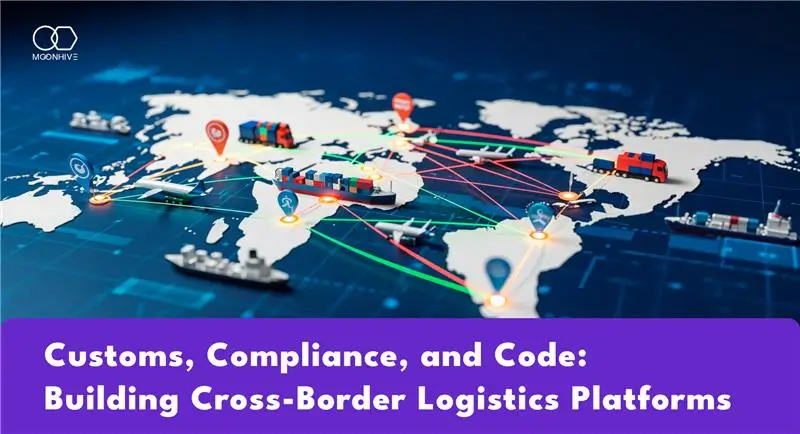In building a cross-border logistics platform has become both a golden opportunity and a complex challenge. With international e-commerce booming and trade routes evolving rapidly, businesses need digital-first logistics systems that simplify compliance, streamline customs, and deliver real-time tracking. Success in this space lies at the intersection of technology, regulation, and local insight. For founders just getting started, you may also want to read our blog on how to build your MVP the right way.
Why the Cross-Border Logistics Platform Market Is Booming
Cross-border logistics is experiencing rapid expansion because businesses and consumers alike demand faster, more transparent, and cost-effective global deliveries. Customers today expect the same seamless experience whether they are ordering from a local vendor or a business halfway across the world. This shift in expectations has driven a surge in digital logistics solutions that can provide visibility across the supply chain, automate repetitive processes, and scale quickly as demand grows. At the same time, international trade introduces challenges such as customs procedures, tariffs, taxes, and infrastructure limitations unique to each country. Companies that successfully address these challenges position themselves as trusted partners in global trade. If you’re interested in how startups can adapt to regional challenges, check out our post on building startups in the UAE and navigating compliance.
Customs in a Cross-Border Logistics Platform: Beyond Forms and Fees
Customs clearance is one of the most significant factors influencing delivery timelines in cross-border logistics. It is not simply a matter of filling out forms it is a critical step that can determine whether goods arrive on time or get delayed for weeks. Mistakes in documentation often lead to penalties, additional costs, or shipment holds. To minimize these risks, logistics platforms must automate the generation of documents such as invoices, packing lists, and waybills.
They should also include built-in duty and tax calculators that adapt to country-specific regulations. An integrated HS code database and real-time APIs with customs authorities, such as Dubai Customs or CBSA Canada, enable platforms to streamline processes and reduce human error. By embedding customs automation into the MVP itself, startups gain a competitive advantage while avoiding costly delays. For more insights on early-stage pitfalls, see our blog on 10 mistakes to avoid when launching a startup.
Compliance in a Cross-Border Logistics Platform
Compliance is another cornerstone of cross-border logistics. Every region operates under its own framework of laws governing imports, exports, and data privacy. Overlooking these regulations can lead to audits, blocked shipments, or legal consequences. A successful logistics platform must account for region-specific compliance requirements such as GDPR in Europe or CCPA in California, while also meeting industry standards including ISO certifications and SOC 2 compliance for cloud infrastructure.
Equally important is building dynamic compliance engines that adapt quickly to regulatory updates. By designing platforms with compliance at their core rather than treating it as an afterthought, businesses reduce operational risk and build credibility with both partners and customers.
Code and Engineering with Scale in Mind
A cross-border logistics platform is far more than a dashboard for shipments. Behind the interface lies a deeply integrated ecosystem that connects courier APIs, inventory management systems, ERP solutions, and billing platforms. Real-time fleet tracking using IoT and telematics is increasingly critical for providing visibility across supply chains. Founders must choose their technology architecture carefully at the MVP stage.
Decisions such as whether to adopt a monolithic system, microservices, or serverless architecture can shape the scalability and efficiency of the platform for years to come. Building security and performance monitoring into the foundation ensures that as the platform scales, it continues to meet customer expectations without major disruptions. Poor technical decisions made early in development often result in costly re-engineering later, so thoughtful planning is essential.
Key Takeaways
The foundation of a successful cross-border logistics platform lies in its ability to integrate customs automation, compliance-by-design, and real-time visibility into one seamless system. An MVP should focus on solving a critical bottleneck such as customs delays or lack of shipment tracking. Since regulatory environments differ across regions, platforms must be modular and adaptable, enabling rapid updates as rules change.
Finally, scalability depends on integrations no logistics system exists in isolation, and the ability to connect effortlessly with courier services, inventory platforms, and compliance databases defines long-term success.
What’s Next?
The future of cross-border logistics will be defined by automation, compliance intelligence, and predictive analytics. Platforms that invest in these areas will not only reduce operational risks but also deliver the efficiency and transparency that global businesses demand. Founders and startups can continue to focus on building systems that balance innovation with reliability, ensuring they are ready to compete in an increasingly borderless world. You may also enjoy our blog on how founders in the UK can reach product-market fit without raising a big round.
